1 Introduction
In recent decades, the worldwide consensus has been that using clean energy sources such as hydro, wind, and solar to replace fossil fuels for electrical power generation is an effective method to deal with increasingly serious air pollution and climate change problems [1]-[5].Proposed by the Global Energy Interconnection Development and Cooperation Organization (GEIDCO), intercontinental power grid interconnection could greatly contribute to the comprehensive use of multiple clean energy sources and reduce the fluctuations associated with wind and solar [6].According to planning research of Global Energy Interconnection Backbone [7], the construction of intercontinental power interconnection projects is key to achieving the goal of satisfying global energy demands by utilizing clean energy within the next 30 years.
With the rapid development of power transmission technology, the delivery of thousands of megawatts of electric power has become a reality in several countries.A particular example is China’s vigorous construction of Ultra High Voltage (UHV) power transmission projects in recent years [8].Conventional techno-economic analysis of power grid project planning covers concepts such as power and electricity balancing, consumption market analysis, and investment estimation.However, referring to the engineering practices and studies of long distance power transmission projects in many countries [9], the construction of a power interconnection project would be influenced by several non-techno-economic impact factors such as political, social, international, and other local impact factors.
This situation causes difficulties for decision makers or investors in terms of fully assessing an intercontinental power interconnection project before implementation.Therefore, a method of recognizing which impact factors would influence the project in a specific country and assessing the degree of influence of these factors on the project is essential for all decision-makers, investors, project implementers, and engineers.There are very few published studies on impact factor evaluation for intercontinental power interconnection projects.A report titled “Crossborder power trading in South Asia: a techno economic rationale” [10] released by the Asian Development Bank in 2015 focused on the influences and risks of cross-border power trading in South Asia.Their analysis showed that the risks of cross-border power trading may stem from the three aspects of politics, business, and technique.In the academic field, Poudineh pointed out that the business model for cross-border power interconnection projects in the Mediterranean basin needed to consider impacts from the three aspects of investment incentive and efficiency, risks and uncertainties, and planning and governance along with 24 sub-factors [11].Rama reviewed six dimensions of social impact on international power grid interconnection [12].Most of these related research papers aimed at finding and analyzing potential impact factors associated with international power grid interconnection in a single country or region.Investment risks were the most popular factors that were analyzed.However, some impact factors bring not only risks to the interconnection project, but also provide opportunities.For example some regional organizations may act as effective platforms to aid the implementation of project planning, policies, finance, and cooperation.There are also many ratings and rankings released annually by international organizations or agencies to evaluate the situations in various countries based on a variety of aspects [13]-[16].These ratings or rankings are provided to interested parties in related countries for different purposes.They can thus be regarded as a general reference and are not specifically provided for engineering projects.Currently, a comprehensive method that balances these two aspects and provides a specific assessment for interconnection projects has not been developed.
In research areas such as project management, operational research, decision-making, plan comparison, and assessment, several multiple impact factor evaluation methods have been reported.For example, a semiquantitative expert consultation method, called Delphi method, was developed for studying the roles and relationships between different impact factors [17].Structural Equation Modeling (SEM) is a statistical analysis technique that combines confirmatory factor analysis and path analysis to analyze the causal relationship between variables [18].Another decision-making method, called Analytic Hierarchy Process (AHP), is currently used in many more applications than originally intended.It is used in decision-making activities such as planning, selecting best alternatives, resource allocation, resolving conflicts, optimization, forecasting, and evaluation.Its flexibility makes it superior in terms of balancing different alternatives or opinions associated with the same target and then to provide a comprehensive evaluation result [19]-[23].This is very suitable for research on intercontinental power interconnection projects.
This paper presents an Analytic Hierarchy Process (AHP)-based model for evaluating impact factors on intercontinental power interconnection projects.The model aims to provide influential analytical aid regarding impact factors other than techno-economic ones.This provides deeper insight into the actual project situation when viewed in parallel with conventional techno-economic analysis.Detailed information regarding the model is introduced in Section 2.In Section 3, as a case study, the model is used to evaluate a proposed power interconnection project between Saudi Arabia and Ethiopia.After further discussion in Section 4, several conclusions are drawn.
2 Model description
We developed a multi-level model to comprehensively evaluate impact factors for intercontinental power grid interconnection project at the pre-assessment phase.We compiled a list of possible impact factors based on information derived from meetings with power engineering experts and on literature studies.Based on this list, the model was developed in two parts.The first part was used to recognize which of the listed factors a project could encounter.The second part assessed the degree of influence of these recognized factors on the project.
2.1 Impact factor list
Intercontinental power interconnection projects are a comprehensive business and engineering activity that could be influenced by various factors such as technology, financing, international trades, geopolitics, local economy, and culture.Based on literature reviews, interviews with experts, and research on existing power interconnection projects, we compiled a list of 14 factors that covered almost all possible aspects an intercontinental power interconnection project may encounter.These 14 factors, listed in Table 1, were divided into three groups.These groups included macro-factors associated with involved countries, energy-economic factors associated with involved countries, and implementation and management factors associated with the project.These 14 factors made up a three-layer project assessment analysis framework.The top layer was the target layer, representing the goal of successful implementation of the intercontinental power interconnection project.The next layer, termed “main factors”, showed three aspects (groups) that an interconnection project could be influenced by.The bottom layer included all 14 detailed factors.In the Appendix, we provide an explanatory table that shows the evaluation instructions for each sub-factor for further evaluation.Please note that this list is not exhaustive.
Table 1 Impact factor analysis framework
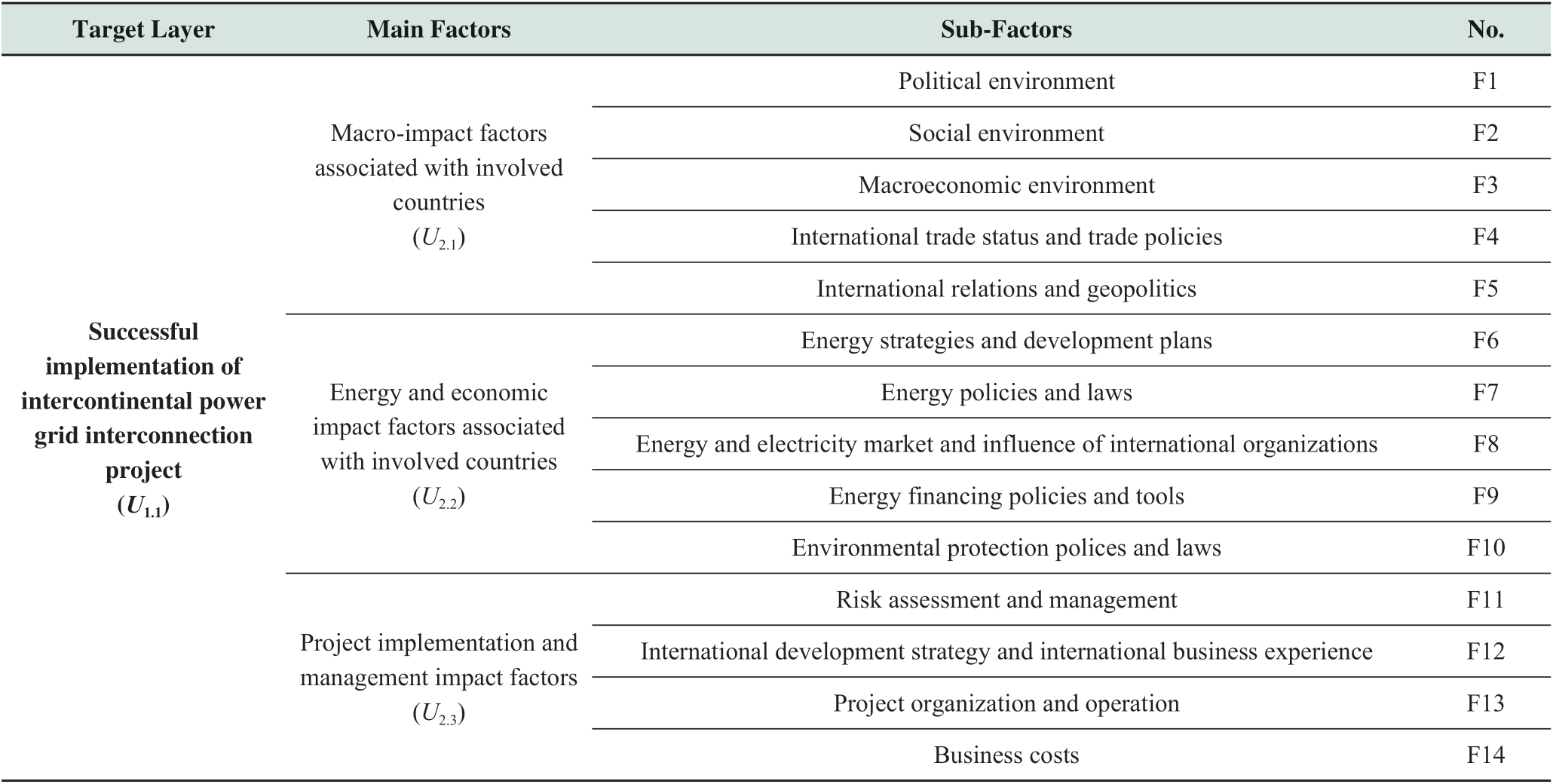
2.2 Model part I: Impact factor recognition in a single country
To assess a specific interconnection project, the impact factors in the analysis framework (Table 1) that are most applicable to this project in a particular country need to be recognized.This is done by applying Part I of our model, which was designed based on the AHP method to first compare the importance between each pair of factors in each group and then to calculate the relative weight of each factor according to the paired comparison results.A comparison matrix A is formed for each group to achieve this goal.The structure of matrix A is shown in Fig.1.Since an intercontinental power interconnection project involves more than one country along the power transmission lines, the impact factor recognition and then the assessment must be performed individually for each country involved in the project.
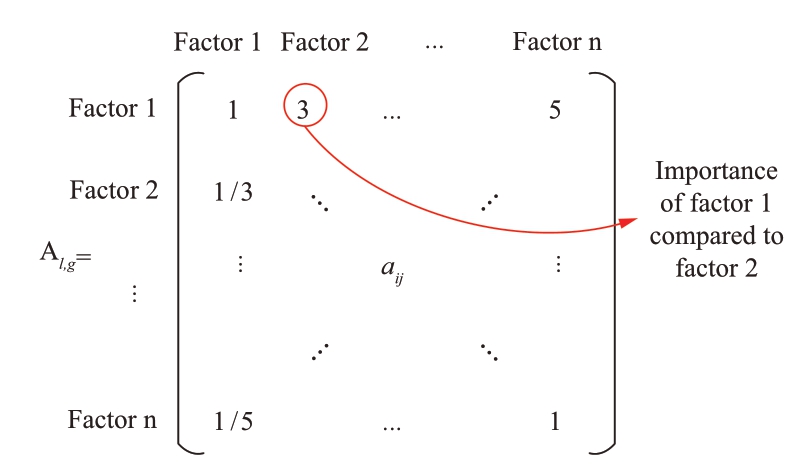
Fig.1 Structure of the comparison matrix A for comparative importance assessments between each factor in a particular group
Each group requires a comparison matrix to calculate the comparative importance of the factors.The subscripts associated with Al,g have the same meaning as Ul.g in Table 1, in which the l indicates the factor layer and the g indicates the group.For example, there are three comparison matrices, namely A2.1, A2.2, and A2.3, formed for the three groups of factors in the sub-factor layer, with 5×5, 5×5, and 4×4 structures, respectively.For the main factor layer, there is only one group that includes three main factors.The comparison matrix for this layer is thus a 3×3 matrix called A1.1.The top layer only contains one factor.There is thus no need for a comparison matrix.
Elements in matrix A are the relative comparison scores supplied by experts for the factor pairs indicated by the subscripts.The scoring criteria for the comparative importance between any two factors are shown in Table 2.The evaluation instructions for each sub-factor in Appendix Table 1 lists the key issues that need to be taken into consideration by experts performing comparative importance assessments between factors.
Table 2 Scoring criteria for comparative importance assessments between each pair of factors in a group
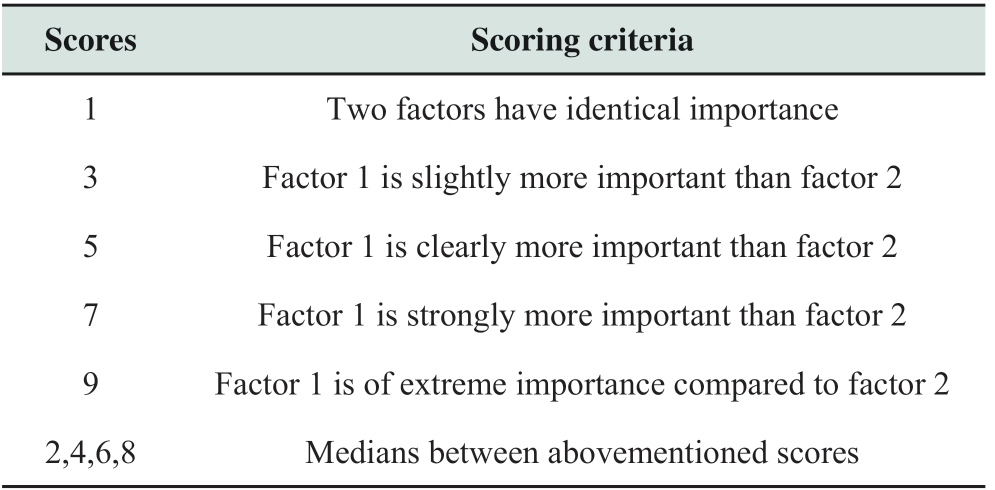
Matrix A thus possesses the following qualities:
It is then necessary to calculate the eigenvalue and eigenvector of matrix A as the relative weight of each factor in a particular group.That is, to generate a normalized eigenvector w that fits:
The elements in the eigenvector w are the relative weight of impact factors in a particular group.
In order to eliminate the influence of stochasticity in scoring and to ensure the consistency of the comparative importance between all factors, a consistency test has to be performed for each matrix A, which requires the calculation of the average consistency ratio CR:
where λmax is the eigenvalue of matrix A.n is the factor number in matrix A, and RI is the rand om index.The values of RI for n<9 are listed in Table 3.All of these RI values were provided in Ref.[19], and were data provided by Prof.Saaty, the proposer of the AHP method.
When the CR for matrix A was less than 0.1, the inconsistency of scores in matrix A was found to be within an acceptable range.Elements in the normalized eigenvector w could be further used as the relative weight of each factor in the evaluated group.When the CR was above 0.1, the scores in matrix A needed to be modified or re-evaluated to get consistent comparative results.
Table 3 RI values based on n
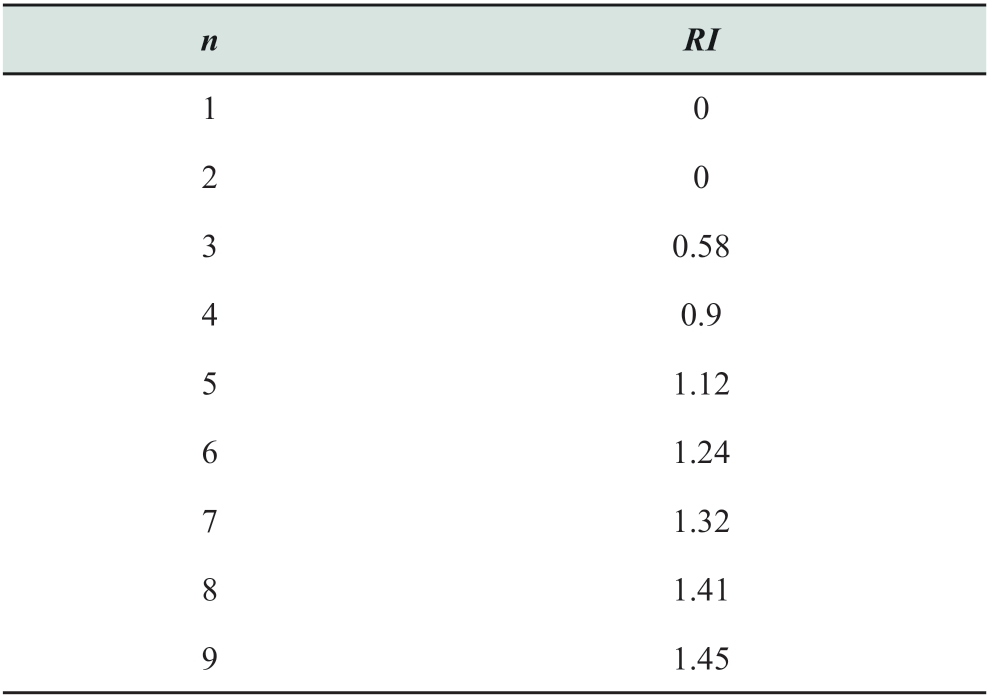
2.3 Model part II: Impact factor assessment in a single country
After the relative weights for each factor of a particular group were generated in part I of the model, it was possible to carry out a further comprehensive assessment of the degree of influence of each impact factor on a particular project.Each country requires a set of influential degree for each group of impact factors for expert assessment, which is given by
These five elements in V represent five degrees of influence that one factor could have on the project.v1 represents vital influence, v2 great influence, v3 normal influence, v4 little influence, and v5 almost no influence.When performing an expert evaluation, a sufficient number of experts (more than 5 is recommended) are required to vote for the degree of influence (according to V) for each factor in one group.The results of their vote (normalized) for a group of impact factors would form an assessment matrix R.The structure of matrix R is shown in Fig.2.Similarly, to matrix A in Section 2.2, the assessment of sub-factors to form matrix R can refer to the evaluation instructions shown in Appendix Table 1.
Therefore with the assessment matrix R for each factor and the resultant relative weights for each factor (corresponding to vector w in Part I of the model), a comprehensive assessments of the intercontinental power interconnection project with respect to each impact factor in a particular group can be achieved with following calculation of vector B:
The subscripts l and g are identical to those used for the previously mentioned group U and matrix A.Fig.2 and (5) show that the assessment vector B also has five elements which correspond to V.The elements in vector B thus represent a comprehensive assessment on the degree of influences of this group of factors with respect to a project.
This assessment process must start from the bottom layer of factors in the analysis framework (Table 1).When the comprehensive assessment is done for the three main factor groups, these three assessment vectors, B2.1, B2.2, and B2.3, together form an assessing matrix R1.1 for the upper main factor layer, which is given by:
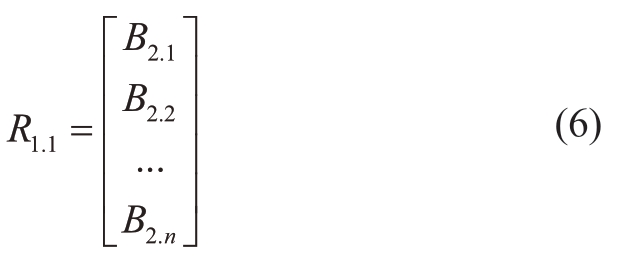

Fig.2 Structure of the assessment matrix R for expert evaluation of each factor in a particular group
Incorporating the relative weight vector w1.1 for this layer, the final assessment for the project implementation in a particular country is given by:
Vector B1.1 also contains five elements that correspond to V.The largest number among the five elements represents the final relative degree of influence (in percentage) of the project implementation in a particular country.
2.4 Comprehensive evaluation of the whole project
As mentioned above, the procedure introduced in Section 2.2 and 2.3 of the evaluation model is intended to be applied to one country involved in the intercontinental power interconnection project.To obtain a comprehensive evaluation result for the whole project, the procedure introduced in Section 2.2 and 2.3 must be repeated for each involved country.The evaluation for each country and the detailed factors of influence along with their varied degrees of influence can then all be shown.Fig.3 shows a diagram of the entire multi-level evaluation model.
3 Case study: Saudi Arabia-Ethiopia power interconnection project
Saudi Arabia is located in West Asia, a location which is strategically significant in terms of connecting Asia, Europe, and Africa.Saudi Arabia is rich in oil and solar energy.The daily average Global Horizontal Irradiance (GHI) in Saudi Arabia can reach 2,000 kWh/m2, one of the highest GHIs in the world.To change the current local economic structure with its excessive reliance on oil and gas export, it is preferable to use solar energy to generate power to replace fossil fuel resources.On the other side of Red Sea, Ethiopia is located in East Africa and rich in hydropower resources.Ethiopia’s technical exploitable capacity of hydropower is as high as 45 GW.Water volume in most of Ethiopia’s rivers has clear seasonal characteristics.Data shows that the generation of hydropower in Ethiopia and solar power in Saudi Arabia have significant complementary characteristics [24], [25].According to related research [7], [24], there is sufficient potential hydropower generated in Ethiopia to be exported after local power demands have been met.If the power grids in Ethiopia and Saudi Arabia are interconnected through a power transmission channel, hydropower from Ethiopia could perfectly meet the power demand in Saudi Arabia and suppress fluctuations of locally generated solar power (Fig.4).
A proposed route for the Saudi Arabia-Ethiopia power transmission channel is presented in Fig.5.This is the geographically optimal path crossing Yemen and Djibouti.With a total transmission length of more than 2,000 km, one possible technical solution is to build a ±660 kV highvoltage direct current (HVDC) transmission line to delivery 4 GW of power [24].In order to perform a comprehensive assessment on this project, the model proposed in Section 2 should be applied to all four involved countries, including Saudi Arabia, Yemen, Djibouti, and Ethiopia.

Fig.3 Multi-level evaluation model diagram

Fig.4 Annual change in power demand in Saudi Arabia and Nile River hydropower output in Ethiopia (Data normalized)
3.1 Impact factor recognition in Saudi Arabia
Following the evaluation model shown in Fig.3, it is necessary to recognize the importance of each factor in the analysis framework (Table 1) of the countries involved in the project.Here, the analysis was begun with Saudi Arabia.The main factor layer was addressed first.

Fig.5 Proposed route of the Saudi Arabia-Ethiopia intercontinental power grid interconnection project
For the three factors in the main factor layer, experts provided the comparative scores for each pair of factors as shown in the following comparison matrix A1.1.

According to scoring criteria in Table 2, the matrix A1.1 showed that the experts believed that the macro-factors, including politics, society, economics, and international relations would influence the project more in Saudi Arabia because the culture, political system, and economic structure differed from the other countries.Considering that Saudi Arabia has shown their willingness to develop and invest in the energy sector, the energy/economic factors and project management factors appeared to be less influential.
Next, for the sub-factor layers, experts also scored each group using the same criteria.The results are shown as the three comparison matrices below:

As can be seen from matrix A2.1, experts believed that the political environment and geopolitics were factors that would be the most influential on the power interconnection project.This is clearly understood if attention is paid to the complicated and volatile political situation in the whole Middle East region.The social environment was the next most influential factor because of cultural and religious differences.Considering the good economic conditions of Saudi Arabia, the macro-economic environment and international trades were less influential.
Similarly, in A2.2 and A2.3, the expert scores showed that the energy policies and related laws in Saudi Arabia may be more influential than other energy/economic factors.Additionally, the risk assessment and management aspects were more influential than the other project implementation and managerial factors.The relative weight of factors in each group of paired comparative results was obtained by calculating the eigenvectors of A1.1, A2.1, A2.2, and A2.3.The results are shown in Fig.6 as percentages.These represent the recognized results between the different impact factors for the Saudi Arabia interconnection project.In the consistency test, calculations showed that all scores in matrices A1.1-A2.3 were consistent amongst themselves (Table 4).There was no need to modify the scores or to re-evaluate them.

Fig.6 Relative weights of the 14 impact factors for project implementation in Saudi Arabia The colors in the figure represent the three main factor groups, with red for macro impact factors, green for energy/economy impact factors, and blue for project management impact factors.For convenience of display, each factor was presented by an FX number index, where X varied from 1 to 14 in accordance with the factors shown in Table 1.
Table 4 Consistency test for impact factor recognition analysis in Saudi Arabia

3.2 Impact factor assessment in Saudi Arabia
The second part of the evaluation model required experts to assess the degree of influence of each factor from the analysis framework individually, based on the assessment set V.Their assessment results, organized by factor group, constituted the assessment matrix R.For the Saudi Arabia-Ethiopia intercontinental power interconnection project, 10 experts participated in the assessment vote to obtain three assessment matrices R2.1, R2.2, and R2.3.

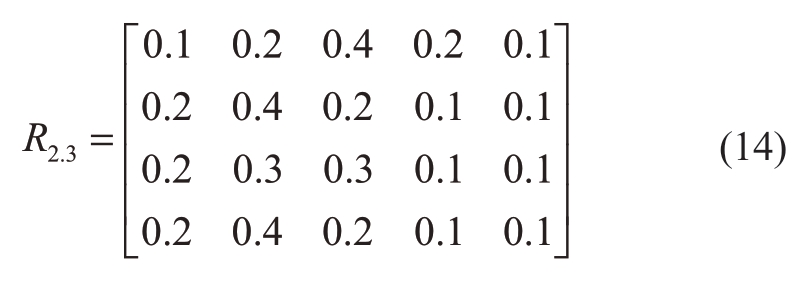
According to (6), comprehensive assessments of each factor that influenced the project could be represented by vector B, which was the matrix multiplication of the normalized eigenvector w and the above assessing matrices R.This process generated the vectors B2.1, B2.2, and B2.3 for the three groups of sub-factors.Thereafter, the final assessment matrix R1.1 was generated by using these three vectors according to (7).Finally, the evaluation results for Saudi Arabia were shown by the vector B1.1 (8), with the normalized results for all four B vectors shown in Fig.7.The elements in each B vector in Fig.7 represent the percentage of the opinion regarding each degree of influence.This means that in the final evaluation result (B1.1), most of the evaluator’s opinions indicated that the implementation of the project in Saudi Arabia had only a weak potential of being influenced by the overall environment.

Fig.7 Comprehensive assessment results of the impact factors in Saudi Arabia The colors represent the degree of influence of each factor.The three bars on the left are assessments of the three main impact factors.B2.1 represents macro factors, B2.2 represents energy/economic factors, and B2.3 represents project management factors.The bar on the right represents the final assessment results (B1.1) for project implementation in Saudi Arabia.

Fig.8 Relative weights of 14 impact factors for project implementation in Yemen (1), Djibouti (2), and Ethiopia (3).The colors and number indices are identical to those of Fig.6.
3.3 Comprehensive project evaluation results
Similar analyses were performed for the other three involved countries of Yemen, Djibouti, and Ethiopia.The impact factor recognition (relative weights of each factor) in each country are shown as percentages in Fig.8.The final evaluations on impact factors in each of the four countries are shown in Fig.9.
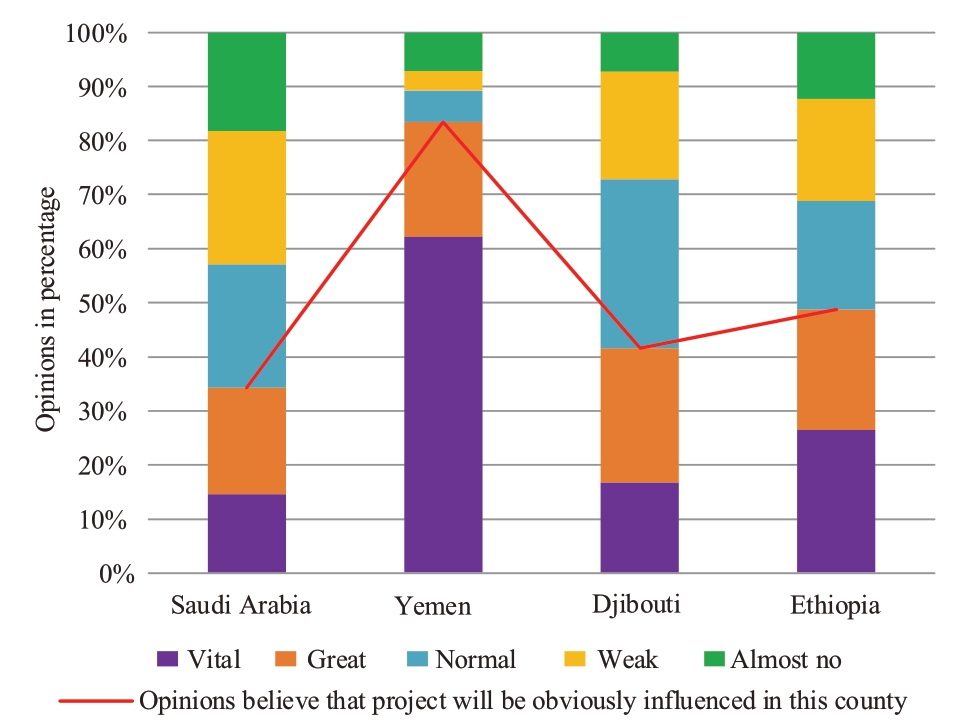
Fig.9 Final evaluation results for influences on the Saudi Arabia-Ethiopia intercontinental power interconnection project, representing the status of all four involved countries.The red curve shows the percentage of opinions that indicate that this project will be significantly influenced by this country (the sum of vital and great influence percentages).
In addition to the evaluations of the four involved countries, Fig.9 also shows the total percentage of evaluations that indicated that the status quo of an evaluated country will have a clear influence on the power interconnection project.It can be seen that the proportion of opinions that indicate that the project will be affected by Saudi Arabia is the lowest, accounting for only approximately 34%, while in Djibouti and Ethiopia, it is approximately 40%, slightly higher than for Saudi Arabia.However, it was considered that the project would be significantly affected in Yemen.
3.4 Conclusions and suggestions for the Saudi Arabia-Ethiopia power interconnection project
Based on the results of applying the model, the evaluation of the Saudi Arabia-Ethiopia power interconnection project can be summed up as follows:
(1) Results from the model showed that the prospects for the future construction of this project using the proposed route were good.Amongst the four involved countries, the status quos in Saudi Arabia, Djibouti, and Ethiopia all showed good evaluations in terms of project implementation.The only concern was the unstable condition in Yemen due to the civil war.
(2) In each country, project investors would still need to pay attention to the influence of various factors.In Saudi Arabia, the main influence on the project may come from its special policies on energy, finance, and environmental protection.In Yemen, the turbulent political and social environment are the most likely source of impact on the project.This has led to the country’s inability to formulate relevant strategies and policies in terms of energy, electricity, trades, and even public security.In Djibouti and Ethiopia, possible influences may come from project management aspects, such as risk management, local cooperation with collaborators from different religious and cultural backgrounds, and lack of international business experiences.
Proposed suggestions for future implementation of the project based on these conclusions are as follows:
(1) Though there are good prospects in terms of the project evaluation, investors still need to pay attention to the potential influences due to differences in culture, religious customs, and laws in Saudi Arabia, Ethiopia, and Djibouti, especially in communication with local partners, collaborators, and employees.
(2) An alternative route for the power transmission line that avoids crossing Yemen could be taken into consideration by project investors and planners.An example is shown in Fig.10.However, since the Yemen route is geographically optimal, other proposed routes that bypass Yemen will inevitably increase construction cost, especially for the submarine power cables.The transmission line route shown in Fig.10 requires 550 km longer submarine cables than the optimal route shown in Fig.5, which will definitely lead to much higher investments.

Fig.10 Alternative route for the Saudi Arabia-Ethiopia intercontinental power grid interconnection project that avoids crossing Yemen
4 Discussion
Th e purpose of the model detailed in this paper was to provide a more comprehensive analysis of the impact of all possible aspects on intercontinental power interconnection projects that involve multiple countries.Based on the qualitative analysis of single impact factors, this model takes a further step that provides a comprehensive conclusion, balancing the influence of multiple factors through a semi-quantitative method, which would effectively help all decision makers, investors, project planners, and implementers to obtain a clearer and more generalized insight into the project.
An important point should be noted in the use of this model.Different factors will impact the project in different ways.As mentioned in the introduction section, the appearance of some factors would help or provide a better environment for the implementation of the project, while the appearance of others would have the opposite effect and exert a negative influence.This requires special attention in terms of qualifying each specific factor while using the model.This is also the reason for the difficulty associated with setting consistent scoring criteria for assessment.We provided a detailed explanation of the evaluation instructions for each sub-factor in the model in Appendix Table 1.All explanations presented here show the possible directions for evaluation.Because of the diversity and complexity of impact factors, the evaluation instructions for each impact factor are not limited to what is shown on the table.
There are two potential improvements to the model that can be made in future studies.As mentioned above, this model is a semi-quantitative one that still requires expert scores and opinions on each specific impact factor.A quantitative assessment process for impact factors is required for such topics.This is definitely the most difficult issue facing this type of research.The other improvement or suggestion in terms of using this model may be found in evaluating some of the impact factors by referring to other public rankings, especially for political or economic impact factors.
Many global organizations and agencies publish various rankings on special topics for evaluation of the situations in various countries and regions.For example, the Worldwide Governance Indicators (WGI) published by the World Bank [14] rates over 200 countries and territories according to the six dimensions of governance, including voice and accountability, political stability and absence of violence, government effectiveness, regulatory quality, rule of law, and control of corruption.This result is a good reference for evaluating the impact factor F1 of the political environment of a country involved in a project.Similar ranks or indicators such as the International Country Risk Guide [15], published by the Political Risk Service Group and the Safety and Security indicator in The Travel & Tourism Competitiveness Report [16] released by the World Economic Forum, can all be used as references in the rating procedure when using our model.Meanwhile, these references could be used to further extend the model when doing more detailed analysis on specific impact factors.For example, if using abovementioned WGI in further analyzing the impact factor of Political Environment, the six dimensions of governance could be introduced into the framework of the model as sub-factors of F1.Using the same analysis procedure presented in Sections 2.2 and 2.3, a more detailed evaluation result for the influence of the political environment on the project will be generated.
However, these different ranks and indicators are based on systems that focus on issues other than intercontinental power interconnection engineering projects.Therefore, we believe that there still needs to be a comprehensive assessment in terms of referring them to an intercontinental power interconnection project.This is also the reason that we did not choose any of the existing commercial or noncommercial indicators as the only criteria for impact factor evaluation in our model.
5 Conclusion
This study presents an evaluation model for impact factor recognition and assessment for intercontinental power grid interconnection projects.Based on a multi-layer analysis framework including 14 impact factors, the model could combine expert evaluations of the influence of each individual factor on the project into one comprehensive assessment result.The method is more accurate and easier to use than alternative assessment models.A case study evaluation of the Asia-Africa power interconnection project from Saudi Arabia to Ethiopia was then conducted using the model.Results showed that the prospects for the project using the geographically optimal route crossing Yemen and Djibouti were good.The only concern was found to come from the unstable political and social conditions in Yemen.Several suggestions were thus proposed based on the evaluation results.
It is currently difficult to entirely quantitatively evaluate the influence of some political, social, or policy-related factors on engineering projects.This makes the evaluation reliant on expert opinions.Although the model presented in this paper is still a semi-quantitative one that requires expert evaluation, it represents one further step towards analyzing these opinions to obtain a single, comprehensive, and objective assessment result.For other intercontinental or cross-border power interconnection projects, this model could effectively help decision makers or investors at the early project design and planning stage in parallel with conventional techno-economic analysis of the project.An overarching and detailed description of the project can thus be provided.
Acknowledgements
This work was supported by the State Grid Science and Technology Project “Research on Method and Evaluation Principle for the Cross-Continent Power Transmission Planning Scheme” (SGTYHT/16-JS-198).
References
[1] Dincer I (2000) Renewable energy and sustainable development: a crucial review.Renewable & Sustainable Energy Reviews, 4(2):157-175
[2] Boyle G (2004) Renewable energy.Oxford University Press, London
[3] Panwar NL, Kaushik SC, Kothari S (2011) Role of renewable energy sources in environmental protection.Renewable & Sustainable Energy Reviews, 15(3):1513-1524
[4] Ellabban O, Abu-Rub H, Blaabjerg F (2014) Renewable energy resources: Current status, future prospects and their enabling technology.Renewable & Sustainable Energy Reviews, 39:748-764
[5] Pazheri FR, Othman MF, Malik NH (2014) A review on global renewable electricity scenario.Renewable & Sustainable Energy Reviews, 31:835-845
[6] Liu ZY (2015) Global Energy Interconnection.Academic Press, Beijing
[7] Li J, Song FL, Yu XX (2018) Research on global energy interconnection backbone grid planning.Global Energy Interconnection, 1(5):527-536
[8] Liu ZY (2013) Ultra High Voltage AC & DC Grid.China Electric Power Press, Beijing
[9] Puka L, Szulecki K (2014) The politics and economics of crossborder electricity infrastructure: A framework for analysis.Energy Research & Social Science, 4:124-134
[10] Wijayatunga P, Chattopadhyay D, Fernando PN (2015) Crossborder power trading in south Asia: a techno economic rationale.Manila, Asian Development Bank, 6-7
[11] Poudineh R, Rubino A (2017) Business model for cross-border interconnections in the Mediterranean basin.Energy Policy, 17:96-108
[12] Rama ST (2015) A review on social impact of international interconnection of power grid.Journal of Energy Technologies and Policy, 5(5):12-19
[13] Institute for Economics & Peace (2019) Global Peace Index 2019: Measuring Peace in a Complex World, Sydney
[14] The Worldwide Governance Indicators (WGI) project (2019) World Bank, http://info.worldbank.org/governance/wgi.Accessed 2 Apr 2019
[15] International Country Risk Guide (ICRG) (2018) The PRS Group, https://epub.prsgroup.com/products/international-countryrisk-guide-icrg.Accessed 2 Apr 2019
[16] The Travel & Tourism Competitiveness Report 2017 (2017) World Economic Forum, https://www.weforum.org/reports/ the-traveltourism-competitiveness-report-2017.Accessed 2 Apr 2019
[17] Okoli C, Pawlowski SD (1969) The Delphi method as a research tool: an example, design considerations and applications.Information & Management, 42(1):15-29
[18] Anderson JC, Gerbing DW (1988) Structural equation modeling in practice: A review and recommended two-step approach.Psychological Bulletin, 103(3):411-423
[19] Saaty RW (1987) The analytic hierarchy process—what it is and how it is used.Mathematical Modelling, 9(3-5):161-176
[20] Vaidya OS, Kumar S (2006) Analytic hierarchy process: An overview of applications.European Journal of Operational Research, 169:1-29
[21] Ho W (2008) Integrated analytic hierarchy process and its applications - A literature review.European Journal of Operational Research, 186:211-228
[22] Hofer T, Sunak Y, Siddique H, Madlener R (2016) Wind farm siting using a spatial Analytic Hierarchy Process approach: A case study of the Städteregion Aachen.Applied Energy, 163:222-243
[23] Strantzali E, Aravossis K (2016) Decision making in renewable energy investments: A review.Renewable and Sustainable Energy Reviews, 55:885-898
[24] GEIDCO (2019) Research and outlook on African Energy Interconnection, China Electric Power Press, Beijing
[25] GEIDCO (2019) Research and outlook on Asian Energy Interconnection, China Electric Power Press, Beijing
Appendix
Table 1 Evaluation instructions for ascertaining the impact of each sub-factor

continue
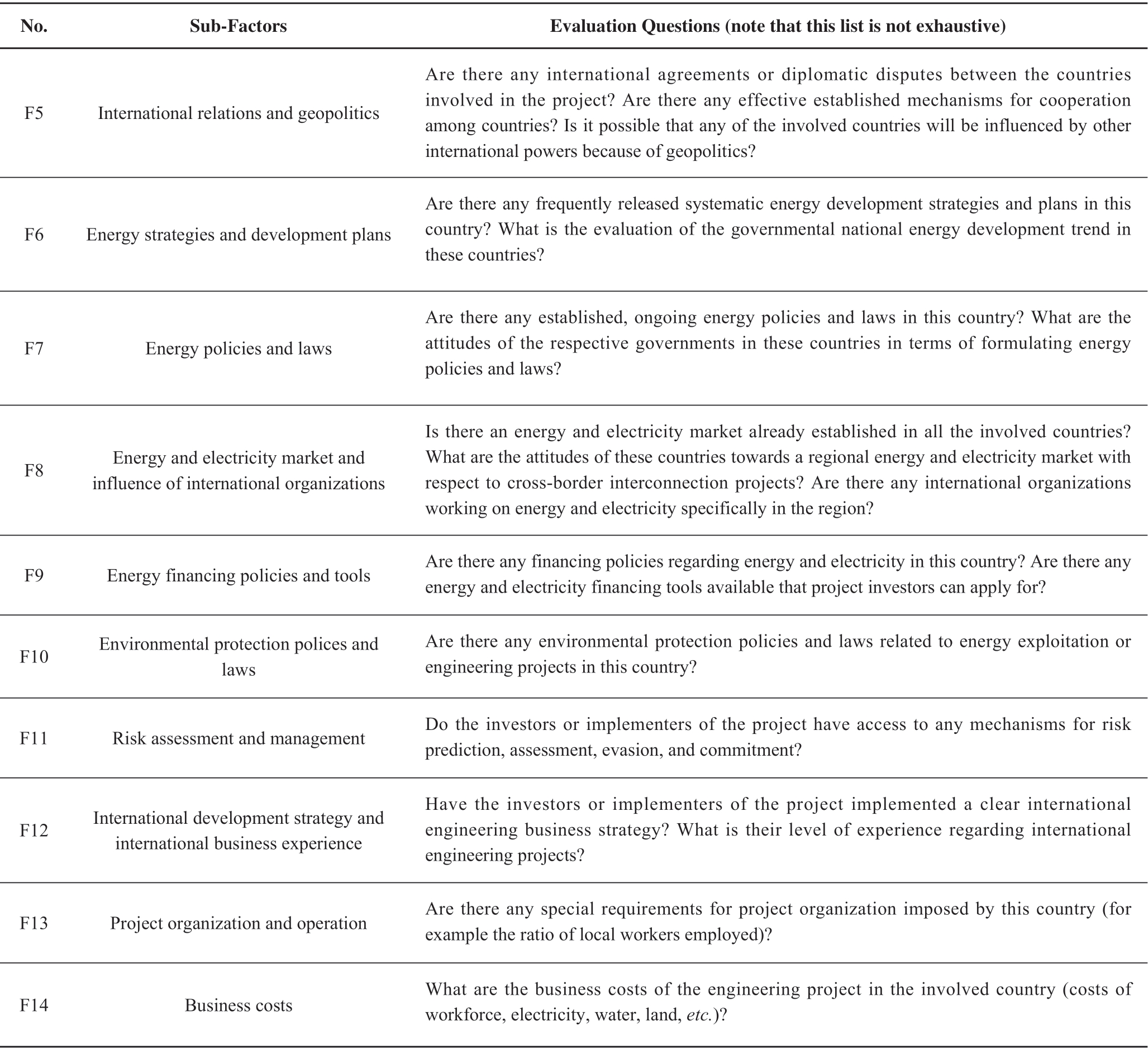







Scan for more details
Received: 31 August 2019/ Accepted: 9 October 2019/ Published: 25 February 2020
 Chen Chen
Chen Chen
c-chen@geidco.org
Caihao Liang
caihao-liang@geidco.org
Yuanbing Zhou
zhouyuanbing@geidco.org
Chen Wang
chen-wang@geidco.org
Jing Lu
lujing@sgeri.sgcc.com.cn
Fei Xu
sophiexufei@hotmail.com
2096-5117/© 2020 Global Energy Interconnection Development and Cooperation Organization.Production and hosting by Elsevier B.V.on behalf of KeAi Communications Co., Ltd.This is an open access article under the CC BY-NC-ND license (http: //creativecommons.org/licenses/by-nc-nd/4.0/ ).
Biographies
Chen Chen received Ph.D.degree in Electrical Engineering at Xi'an Jiaotong University, Xi’an, China, 2018.He is now working in Global Energy Interconnection Development and Cooperation Organization, Beijing.His research interests include power system planning and renewable energy integration.
Caihao Liang received PhD degree in Electrical Engineering at Huazhong University of Science and Technology, China, 2006.He is now working in GEIDCO as the deputy director of the Electric Power Planning Research Division.His research interests include intelligent optimization algorithms, power system planning and analysis, and renewable energy.
Yuanbing Zhou is the Director of Economic & Technology Research Institute at the Global Energy Interconnection Development and Cooperation Organization (GEIDCO), special allowance expert of the State Council, Director of China Renewable Energy Association, and member of the Expert Committee of the Think Tank Alliance of the SOEs.His research interests and experiences are related to energy and electricity strategy and master-plan, energy policy, clean energy and smart grid, energy interconnection etc.
Chen Wang received MSc degree at Imperial College London, 2013.He is working in Global Energy Interconnection Development and Cooperation Organization, Beijing.His research interests include system modelling and optimal control, key technologies and analysis of international power interconnection and Ultra High Voltage power grids.
Jing Lu received master degree at Xi'an Jiaotong University, Xi'an, 2009.She is working in State Grid Energy Research Institute Co., Ltd.Her research interests include renewable energy gird-connected and economic operation analysis.
Fei Xu received MBA degree at IPAG business school, Nice, France, 2012.She is working in Chinese Academy of International Trade and Economic Cooperation, MOFCOM.Her research interests include commodity big data, international market analysis.
(Editor Dawei Wang)
